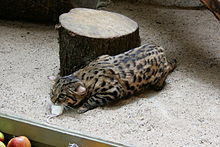| Black-footed cat | |
|---|---|
 | |
 | |
| Distribution of the black-footed cat |
The black-footed cat (Felis nigripes), also called small-spotted cat, is the smallest African cat and endemic to the southwestern arid zone of Southern Africa. It is listed as Vulnerable on the IUCN Red List since 2002, as the population is suspected to decline due to bushmeat poaching, persecution, traffic accidents and predation by domestic animals.
Characteristics[edit]
The black-footed cat is the smallest wild cat in Africa and rivals the rusty-spotted cat as the world's smallest wild cat. ...
Despite its name, only the pads and underparts of the cat's feet are black. The cat has a stocky build with round ears, large eyes, and short black-tipped tail. The fur varies in color from cinnamon-buff to tawny, and is patterned with black or brown spots that merge to form rings on the legs, neck, and tail. These patterns help the animal camouflage. However, the back of their ears are the same color as the background color of their fur. They have six mammae and, unlike other species of spotted cats, non-pigmented skin.[10]
Distribution and habitat[edit]
The black-footed cat is endemic to southern Africa, and primarily found in South Africa, Namibia, marginally into Zimbabwe, and likely in extreme southern Angola. Only historical but no recent records exist in Botswana. It lives in dry, open savanna, grassland and Karoo semidesert with shrub and tree cover at altitudes up to 2,000 m (6,600 ft), but not in the driest and sandiest parts of the Namib and Kalahari Deserts.[2] During the night, they need sparse shrub and tree covers to hunt but spend the daytime in burrows or empty termite mounds.[10][11]
Ecology and behavior[edit]
Black-footed cats are solitary and strictly nocturnal, thus rarely seen. They spend the day resting in dense cover, in unoccupied burrows of springhares, porcupines, and aardvarks, or in hollow termite mounds. They emerge to hunt after sunset.[6]
They are typically found in dry, open habitat with some degree of vegetation cover. Apparently, they get all the moisture they need from their prey, but will drink water when available.[8]
Unlike most other cats, black-footed cats are poor climbers, and will generally ignore tree branches. Their stocky bodies and short tails are not conducive to tree-climbing.[12] They dig vigorously in the sand to extend or modify burrows for shelter.[10]
Black-footed cats are highly unsociable animals that seek refuge at the slightest disturbance. When cornered, they are known to defend themselves fiercely. Due to this habit and their courage, they are called miershooptier(anthill tiger in Afrikaans) in parts of the South African Karoo. They rarely use termite mounds for cover or for bearing their young. A San legend claims that a black-footed cat can kill a giraffe by piercing its jugular. This exaggeration is intended to emphasize the bravery and tenacity of the animal.[13] The only times this behavior differs is when it is time to breed or they are a female with dependent kittens.[3][10]
Within one year, a female covers an average range of 10 km2 (3.9 sq mi), a resident male 22 km2 (8.5 sq mi). The range of an adult male overlaps the ranges of one to four females.[3] On average, the animal travels 8 km (5.0 mi) per night in search of prey. The cats use scent marking throughout their ranges, with males spraying urine up to 12 times an hour. Other forms of scent marking include rubbing objects, raking with claws, and depositing faecesin visible locations. Their calls are louder than those of other cats of their size, presumably to allow them to call over relatively large distances. However, when close to each other, they use quieter purrs or gurgles, or hiss and growl if threatened.[10]
Diet and hunting[edit]
Due to their small size, black-footed cats hunt mainly small prey species, such as rodents and small birds, but may also take the white-quilled bustard and the Cape hare, the latter heavier than itself. Insects and spidersprovide less than 1% of the prey mass consumed.[14][15] They are known to occasionally scavenge the lambs of springboks. They are unusually active hunters, killing up to 14 small animals in a night. Their energy requirementsare very high, with about 250 g (9 oz) of prey per night consumed, which is about a sixth of its average body weight.[10]
Black-footed cats hunt mainly by stalking, rather than ambush, using the cover of darkness and all available traces of cover to approach their prey before the final pounce. They have been observed to hunt by moving swiftly to flush prey from cover, but also to slowly stalk through tufts of vegetation. Less commonly, they wait outside rodent burrows, often with their eyes closed, but remaining alert for the slightest sound.[6] In common with the big cats, but unlike most other small species, black-footed cats have been observed to hide some of their captured prey for later feeding, rather than consuming it immediately.[14][10]







No comments:
Post a Comment